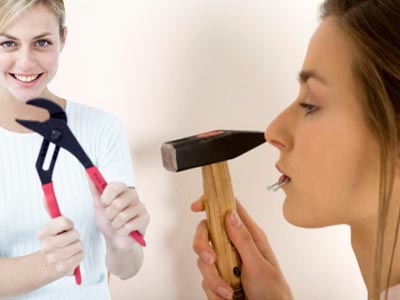We have covered hundreds of articles on Home Improvement and home appliance care in our women portal – Targetwoman. It dawned on us last week – when our front office lock jammed and held us captive inside for a few hours until an enterprising colleague decided to take matters into her hand and released the lock by unscrewing the lock’s outer bezel … that women can be very handy too as much as their male counterparts – only if they had the right knowledge and tools.
With that enlightenment, a consensus was arrived to the immediate effect that some kind of detailed information and steps to become a “handywoman” must be included in our repertoire.
Our Admin who has over 10 years of experience as an electronics bench service engineer in his earlier avatar was roped in to write about this series on – Handywoman.

We will cover some easy hands-on projects in this section as well to illustrate that anyone can attempt and complete successfully easy household tasks and home maintenance with the right information and right tools. It is not rocket science and all you need is a bit of patience to learn a few basic skills.
With that as the prelude to this section, we start with the basic hand tools.
Tools last a lifetime if you buy the right quality tools. Generally speaking hand tools are made of forged steel and should last for generations. Do not buy cheap quality tools. They can cause potential injury and invariably useless. Buy only the best quality tools and working with them can be a pleasure. And most importantly use a tool for what it was intended. Never try to substitute a tool for another most appropriate tool.
Any toolkit worthy of its name should at least include all of the following:
1. Screw Drivers – A set of straight bladed – slotted (old fashioned but still in use ) and cross slotted (Philips and Pozidriv). The most versatile for home use is the screw driver set with detachable head and various bits. Still you may need a long bladed straight blade screwdriver to reach inside some cabinets. Screw drivers come in all sizes – from small miniature jewel- makers screw driver set to standard sizes. Use the right size bit for the size of the head of the screw. A wrong bit can chip away the head and you will be stuck with it.
If the screw refuses to budge, leave a drop of penetrating oil to slacken it.
Some battery operated (electric) screwdriver sets are available which makes life easy when you need to fix many screws in a short time. For occasional use, you will be better off with a manual set of screwdrivers. Battery operated power tools, as we will see later in this series, pose some limitations. You need to keep the batteries in a charged state at all times. Nickel cadmium batteries or the heavier lead-acid storage batteries do not take kindly to long periods of discharged conditions.
2. Pliers – Cutting pliers or combination pliers and a long nosed pliers. Get the pliers with thick plastic wrapped handles for working on electric circuits. Comes easy on your hands too.
3. Hammer – A claw hammer is preferable over a ball-peen hammer. The latter which has a hemispherical head is more useful for tapping punches and rivets. A claw hammer comes in handy to pull nails. Check your hammers before you use them as any loose head or damaged handle can result in catastrophic injury to anyone nearby. Wear thick padded gloves and safety goggles when you use a heavy hammer to avoid injury.
We will add more tools to our kit as we go along ….
